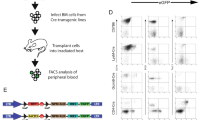Abstract
Amphotropic murine leukemia virus (MLV) replicates in cells from various mammalian species, including humans, and is a potential contaminant in MLV vector preparations for human gene transfer studies. Mus dunni fibroblasts are routinely used for amplification and detection of contaminating virus. We have recently characterized an amphotropic MLV mutant lacking the 75-bp viral enhancer elements and spontaneous MLV-(RCMV) recombinants that have acquired cytomegalovirus (CMV) transcription elements. Both of these viruses replicate in specific human cell types. To test whether the formation of such viruses can be detected and controlled with current routine procedures, we have analyzed the replication of these amphotropic MLV mutants in Mus dunni fibroblasts. We find that M. dunni cells are permissive for enhancer-deficient and CMV promoter-recombinant MLV from several human cell lines. Thus, M. dunni fibroblasts are suitable for the amplification and subsequent detection of enhancer-deficient and enhancer-recombinant MLV in vector preparations.
This is a preview of subscription content, access via your institution
Access options
Subscribe to this journal
Receive 12 print issues and online access
$259.00 per year
only $21.58 per issue
Buy this article
- Purchase on Springer Link
- Instant access to full article PDF
Prices may be subject to local taxes which are calculated during checkout



Similar content being viewed by others
References
Hartley JW, Rowe WP . Naturally occurring murine leukemia viruses in wild mice: characterization of a new ‘amphotropic’ class J Virol 1976 19: 19–25
Rasheed S, Gardner MB, Chan E . Amphotropic host range of naturally occuring wild mouse leukemia viruses J Virol 1976 19: 13–18
Miller AD, Law MF, Verma IM . Generation of helper-free amphotropic retroviruses that transduce a dominant-acting, methotrexate-resistant dihydrofolate reductase gene Mol Cell Biol 1985 5: 431–437
Sorge J, Wright D, Erdman VD, Cutting AE . Amphotropic retrovirus vector system for human cell gene transfer Mol Cell Biol 1984 4: 1730–1737
Cone RD, Mulligan RC . High-efficiency gene transfer into mammalian cells: generation of helper-free recombinant retrovirus with broad mammalian host range Proc Natl Acad Sci USA 1984 81: 6349–6353
Marcel T, Grausz JD . The TMC worldwide gene therapy enrollment report (June 1996) Hum Gene Ther 1996 7: 2025–2046
Otto E et al. Characterization of a replication-competent retrovirus resulting from recombination of packaging and vector sequences Hum Gene Ther 1994 5: 567–575
Donahue RE et al. Helper virus induced T cell lymphoma in nonhuman primates after retroviral mediated gene transfer J Exp Med 1992 176: 1125–1135
Chong H, Starkey W, Vile RG . A replication-competent retrovirus arising from a split-function packaging cell line was generated by recombination events between the vector, one of the packaging constructs, and endogenous retroviral sequences J Virol 1998 72: 2663–2670
Hu W-S, Pathak VK . Design of retroviral vectors and helper cells for gene therapy Pharmacol Rev 2000 52: 493–511
Hu W-S, Pathak VK . Design of retroviral vectors and helper cells for gene therapy US Department of Health and Human Services, Food and Drug Administration, Center for Biologics Evaluation and Research. Supplemental guidance on testing for replication competent retrovirus in retroviral vector based gene therapy products and during follow-up of patients in clinical trials using retroviral vectors, 2000.
Lander MR, Chattopadhyay SKA . Mus dunni cell line that lacks sequences closely related to endogenous murine leukemia Viruses and can be infected by ecotropic, xenotropic, and mink cell focus-forming viruses J Virol 1984 52: 695–698
Reuss FU, Berdel B, Ploss M, Heber R . Replication of enhancer-deficient amphotropic murine leukemia virus in human cells Proc Natl Acad Sci USA 2001 98: 10898–10903
Linney E et al. Non-function of a Moloney murine leukaemia virus regulatory sequence in F9 embryonal carcinoma cells Nature 1984 308: 470–472
Hanecak R, Mittal S, Davis BR, Fan H . Generation of infectious Moloney murine leukemia viruses with deletions in the U3 portion of the long terminal repeat Mol Cell Biol 1986 6: 4634–4640
Reuss FU, Heber R, Ploss A, Berdel B . Amphotropic murine leukemia virus replication in human mammary epithelial cells and the formation of cytomegalovirus-promoter recombinants Virology 2001 291: 91–100
Cosset FL et al. High-titer packaging cells producing recombinant retroviruses resistant to human serum J Virol 1995 69: 7430–7436
Yu SF et al. Self-inactivating retroviral vectors designed for transfer of whole genes into mammalian cells Proc Natl Acad Sci USA 1986 83: 3194–3198
Vile RG et al. Tissue-specific gene expression from Mo-MLV retroviral vectors with hybrid LTRs containing the murine tyrosinase enhancer/promoter Virology 1995 214: 307–313
Haapala DK, Robey WG, Orszolan SD, Tsai WP . Isolation from cats of an endogenous type C virus with a novel envelope protein J Virol 1985 53: 827–833
Bassam BJ, Caetano-Anolles G, Gresshoff PM . Fast and sensitive silver staining of DNA in polyacrylamide gels Anal Biochem 1991 196: 80–83
Acknowledgements
We are grateful to H zur Hausen for constant support and for providing the laboratory facilities, to I Hartl and K Cichutek for the Mus dunni fibroblasts and to U Ackermann for expert photographic assistance. This work was supported by a research grant from the Deutsche Forschungsgemeinschaft to FUR.
Author information
Authors and Affiliations
Rights and permissions
About this article
Cite this article
Reuss, F., Berdel, B., Heber, R. et al. Enhancer-deficient amphotropic murine leukemia virus and recombinants with heterologous transcription elements can be efficiently amplified and detected in Mus dunni fibroblasts. Gene Ther 9, 1183–1188 (2002). https://doi.org/10.1038/sj.gt.3301785
Received:
Accepted:
Published:
Issue Date:
DOI: https://doi.org/10.1038/sj.gt.3301785



